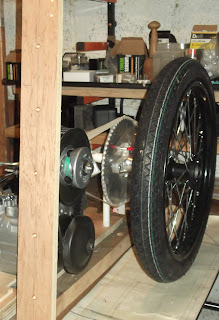A new consignment of Comet Torq-A-Verter torque converters has just cleared customs and, having asked Gemini's Chris Merriman to reserve me one, I am now its proud owner. I had hoped to buy a cheap, generic one, but as those have been out of stock too, and as the more expensive ones were the first available, I decided to treat myself to the added quality.When I started playing with it yesterday, I realised that the supplied 5/16th mounting bolts weren't going to fit my engine, a Honda clone made by Lifan, which is metric, but as I didn't know for sure what thread my holes had, I took the entire engine with me to Suffolk Fasteners, today, and was served by Emma Digby, the daughter of the owner, Damon, who I used to fence with and who has supplied parts for various of my projects (my Austin 101 restoration, my gyrocopter rebuild, and my Chaser microlight build etc).
Emma is incredibly knowledgeable. Another customer reckoned she'd know the fixing I wanted just by glancing at the engine, and wasn't too far off the mark. We tried M8 fines, found that they turned a couple of times then jammed, so tried a standard thread, and those worked perfectly. If you are local, or even if you need to source fixings online, you really must support Suffolk Fasteners, because it is so seldom that you can get one to one service from experts and be charged for one single bolt, if one is all you need.
This evening I have been playing with my Lifan engine and trying different mounting arrangements for my torque converter. In what may be the best position for it, one of the strengthening webs (or vanes?) clashes with the oil filler metal, so I plan to grind some of it away. I have seen this done on some YouTube videos of torque converter fitting, so hopefully it isn't too badly frowned upon???
I am going to be replacing the exhaust and also moving the petrol tank, so I took these off and explored the engine generally, and comparing the arrangement with my drawings to see if it is all going to line up with the rear axle etc, and its driven plate-wheel assembly.




































